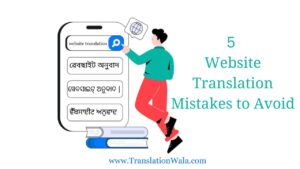Website translation and localization are two distinct but connected ideas. Website translation is the process of turning a website from one language to another, whereas website localization is the process of tailoring a website to its intended audience’s language, culture, and region.
Website Translation

The process of transforming a website from one language to another is known as website translation. This includes translating the text, graphics, and videos on the website, as well as altering the website’s code and functionality to ensure that it works appropriately in the target language.
Although website translation is a simple procedure, it is critical to engage a professional translator to guarantee that the translation is correct and culturally suitable. Machine translation techniques can be useful for simple text translation, but they should not be used for sophisticated or sensitive topics.
Also Read: English to Kannada Translation – Bridging Language Barriers
Website Localization
Website localization is the process of customizing a website to its target audience’s language, culture, and location. This goes beyond simply translating the text on the page. It also entails changing the design, images, and overall tone and style of the website to make it more relevant and appealing to the local audience.
Localization of a website is a more involved procedure than translating. It necessitates a thorough awareness of the target audience’s language, culture, and requirements. It is also critical to be aware of any applicable local rules and regulations to the website.

Differences between Website Translation and Website Localization
The following table summarizes some of the key differences between website translation and website localization:
| Characteristic | Website Translation | Website Localization |
| Focus | Website translation from one language to another | Adapting a website to its intended audience’s language, culture, and location |
| Scope | Only the text, images, and videos on the website can be translated. | This includes translating the text, photographs, and videos on the website, as well as altering the design, iconography, and general tone and style. |
| Complexity | Quite straightforward | More difficult |
| Expertise required | Professional translator | Professional translator with expertise in website localization |
Also Read: Different Types of Localization You Must Know
When to Use Website Translation vs. Website Localization
If all you need is to translate your website into another language, website translation is the way to go. Website localization, on the other hand, is the preferable alternative if you want to reach a global audience and create relationships with clients from other cultures.
Localization of a website is extremely vital for businesses that offer goods or services online. You may make it easier for potential clients to find and understand your products or services by localizing your website. You can also prevent cultural faux pas that could harm your brand’s reputation.
How to Choose a Website Translation or Localization Provider
When choosing a website translation or localization provider, it is important to consider the following factors:
- Experience: Choose a service provider who has experience translating or localizing websites in the target language and culture.
- Qualifications: Choose a service company that has competent and experienced translators and localization workers.
- Quality assurance: Choose a vendor who has a strong quality assurance mechanism in place.
- Customer service: Choose a company with a good reputation for customer service.
Conclusion
Website translation and localization are critical tools for firms seeking to reach a worldwide audience. If you’re not sure which solution is ideal for you, speak with a professional website translation or localization company.



